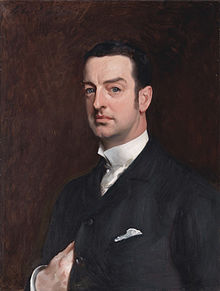Cornelius Vanderbilt II
| Cornelius Vanderbilt II | |
|---|---|

Portrait of Vanderbilt by John Singer Sargent
|
|
| Born |
November 27, 1843 Staten Island, New York, U.S. |
| Died | September 12, 1899 (aged 55) Manhattan, New York City |
| Residence | The Breakers |
| Nationality | American |
| Employer | New York Central Railroad |
| Political party | Republican |
| Spouse(s) | Alice Claypoole Gwynne (m. 1867; his death 1899) |
| Children | Alice Gwynne Vanderbilt William Henry Vanderbilt II Cornelius Vanderbilt III Gertrude Vanderbilt Alfred Gwynne Vanderbilt Reginald Claypoole Vanderbilt Gladys Moore Vanderbilt |
| Parent(s) |
William Henry Vanderbilt Maria Louisa Kissam |
| Relatives | See Vanderbilt family |
| Signature | |
Cornelius Vanderbilt II (November 27, 1843 – September 12, 1899) was an American socialite, heir, businessman, and a member of the prominent United States Vanderbilt family. He was the favorite grandson of Commodore Cornelius Vanderbilt, who left him $5 million, and the eldest son of William Henry "Billy" Vanderbilt (who left him close to $70 million) and Maria Louisa Kissam. In his turn he succeeded them as head of the New York Central and related railroad lines in 1885.
Cornelius Vanderbilt II was born on November 27, 1843 on Staten Island, New York to William Henry Vanderbilt (1821–1885) and Maria Louisa Kissam.
His youngest brother, George Washington Vanderbilt II, commissioned Richard Morris Hunt to design and build Biltmore Estate in Asheville, North Carolina. It was built between 1889 and 1895, and is still owned by Vanderbilt's descendants.
Vanderbilt established a reputation for a strong work ethic while clerking at the Shoe and Leather Bank in New York City. This endeared him to his grandfather, the 'Commodore', who was a strong believer in personal industry.
Vanderbilt was active in numerous organizations including the YMCA, Red Cross, Salvation Army, Trinity Church, St. Bartholomew's Church, Sunday Breakfast Association, and the Newport Country Club.
...
Wikipedia
